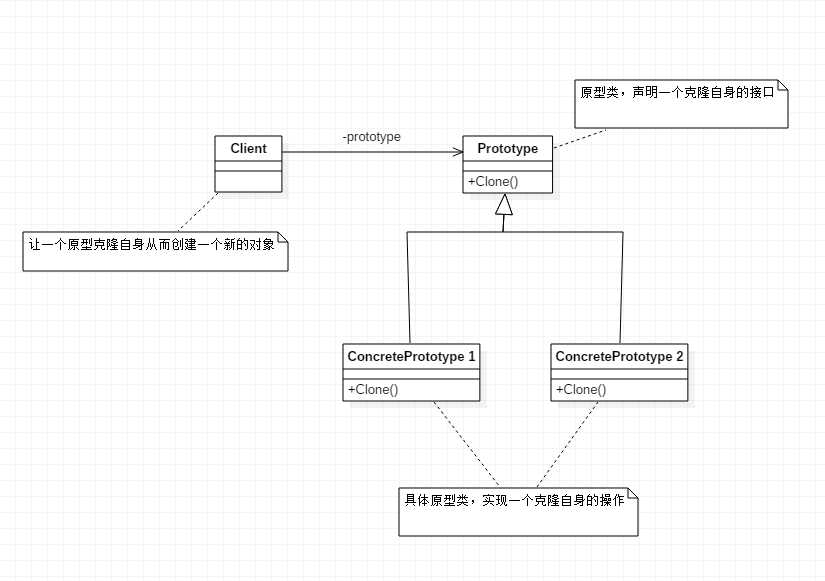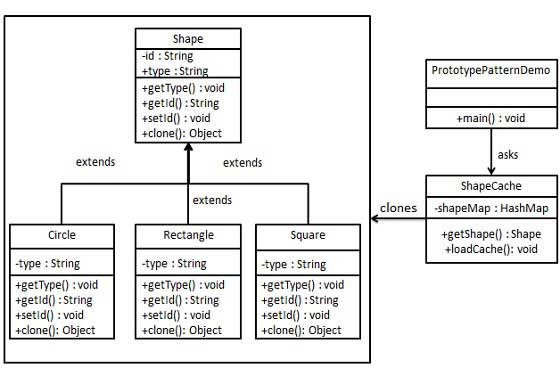原型模式(Prototype Pattern)
Posted
tags:
篇首语:本文由小常识网(cha138.com)小编为大家整理,主要介绍了原型模式(Prototype Pattern)相关的知识,希望对你有一定的参考价值。
(五)原型模式(Prototype Pattern)
1.原型模式(Prototype Pattern)是用于创建重复的对象,同时又能保证性能。这种类型的设计模式属于创建型模式,它提供了一种创建对象的最佳方式。
2.这种模式是实现了一个原型接口,该接口用于创建当前对象的克隆。当直接创建对象的代价比较大时,则采用这种模式。例如,一个对象需要在一个高代价的数据库操作之后被创建。我们可以缓存该对象,在下一个请求时返回它的克隆,在需要的时候更新数据库,以此来减少数据库调用。
3.
原型模式就是从一个对象再创建另外一个可制定的对象,而且不需要知道任何创建的细节。
4.
实现
我们将创建一个抽象类 Shape 和扩展了 Shape 类的实体类。下一步是定义类 ShapeCache,该类把 shape 对象存储在一个 Hashtable 中,并在请求的时候返回它们的克隆。
PrototypPatternDemo,我们的演示类使用 ShapeCache 类来获取 Shape 对象。

步骤 1
创建一个实现了 Clonable 接口的抽象类。
Shape.java
public abstract class Shape implements Cloneable {
private String id;
protected String type;
abstract void draw();
public String getType(){
return type;
}
public String getId() {
return id;
}
public void setId(String id) {
this.id = id;
}
public Object clone() {
Object clone = null;
try {
clone = super.clone();
} catch (CloneNotSupportedException e) {
e.printStackTrace();
}
return clone;
}
}
步骤 2
创建扩展了上面抽象类的实体类。
Rectangle.java
public class Rectangle extends Shape {
public Rectangle(){
type = "Rectangle";
}
@Override
public void draw() {
System.out.println("Inside Rectangle::draw() method.");
}
}
Square.java
public class Square extends Shape {
public Square(){
type = "Square";
}
@Override
public void draw() {
System.out.println("Inside Square::draw() method.");
}
}
Circle.java
public class Circle extends Shape {
public Circle(){
type = "Circle";
}
@Override
public void draw() {
System.out.println("Inside Circle::draw() method.");
}
}
步骤 3
创建一个类,从数据库获取实体类,并把它们存储在一个 Hashtable 中。
ShapeCache.java
import java.util.Hashtable;
public class ShapeCache {
private static Hashtable<String, Shape> shapeMap
= new Hashtable<String, Shape>();
public static Shape getShape(String shapeId) {
Shape cachedShape = shapeMap.get(shapeId);
return (Shape) cachedShape.clone();
}
// 对每种形状都运行数据库查询,并创建该形状
// shapeMap.put(shapeKey, shape);
// 例如,我们要添加三种形状
public static void loadCache() {
Circle circle = new Circle();
circle.setId("1");
shapeMap.put(circle.getId(),circle);
Square square = new Square();
square.setId("2");
shapeMap.put(square.getId(),square);
Rectangle rectangle = new Rectangle();
rectangle.setId("3");
shapeMap.put(rectangle.getId(),rectangle);
}
}
步骤 4
PrototypePatternDemo 使用 ShapeCache 类来获取存储在 Hashtable 中的形状的克隆。
PrototypePatternDemo.java
public class PrototypePatternDemo {
public static void main(String[] args) {
ShapeCache.loadCache();
Shape clonedShape = (Shape) ShapeCache.getShape("1");
System.out.println("Shape : " + clonedShape.getType());
Shape clonedShape2 = (Shape) ShapeCache.getShape("2");
System.out.println("Shape : " + clonedShape2.getType());
Shape clonedShape3 = (Shape) ShapeCache.getShape("3");
System.out.println("Shape : " + clonedShape3.getType());
}
}
步骤 5
验证输出。
Shape : Circle
Shape : Square
Shape : Rectangle
5.总结:一般在初始化的信息不发生变化的情况下,克隆是最好的办法。这既隐藏了对象创建的细节,又对性能是大大的提高。(可参考:http://www.runoob.com/design-pattern/prototype-pattern.html)
以上是关于原型模式(Prototype Pattern)的主要内容,如果未能解决你的问题,请参考以下文章